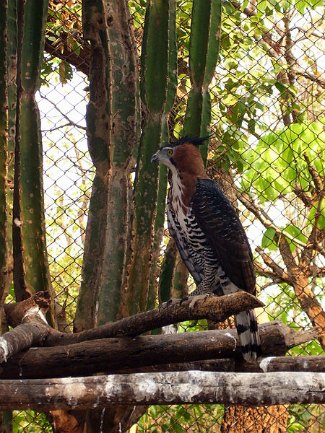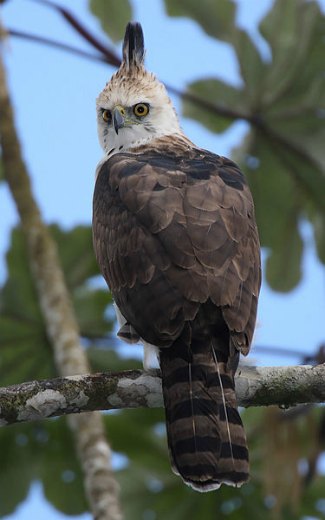Ornate Hawk Eagle - Spizaetus ornatus
Family: Accipitridae
Genus: Spizaetus
Species: S. ornatus
Subspecies: S. o. ornatus, S. o. vicarius
Ornate Hawk Eagles have striking black, white, and chestnut plumage. They live in forest habitats from central Mexico south to the Amazon Basin.
Physical Description:
Ornate Hawk Eagles have a chestnut head and neck with a white throat and chest, a long black crest that can be raised or lowered, and a black back and upperwings. The underparts are white with bold black barring and the long tail is black with three gray-brown bars and a white tip. The eyes are a bright gold and the feet and cere are yellow; the beak is black and sharply hooked. Feathers extend down the leg, which gives them a slightly trousered look. The wings are blunt and rounded in flight, the underwing is pale gray with four black bars, and the lesser wing coverts have white tips. The subspecies S. o. vicarius has brighter chestnut plumage on the head and neck than the nominate S. o. ornatus.
Juveniles are very different from adults. There is no chestnut plumage and instead they have a white head, snowy white underparts with significantly less black barring, and brown-black wings. The tail is black with four or five thin bands of gray and a white tip and underside. They reach full adult plumage after two to three years.
Their call is a short piping sound repeated 2-9 times. Listen to an Ornate Hawk Eagle.
Size:
Length: 58-67 cm
Wingspan: 90-120 cm
Weight: Male: 964 g-1.0 kg. Female: 1.4-1.6 kg.
Habitat and Distribution:
Ornate Hawk Eagles are found in wet primary rainforest, swamp forest, and pine forest in lowlands and foothills, usually from 0-1,200 meters above sea level, though they have been recorded as high as 3,000 m.
By Mdf, GFDL, via Wikimedia Commons
They are found from central Mexico and Central America to South America, both west and east of the Andes Mountains, in northwestern Peru, the Amazon Basin, northern Argentina, and the island of Trinidad, one of the two islands that make up Trinidad and Tobago. They are irruptive, local, or altitudinal migrants within their range, which is 9,430,000 km² from 23°N to 28°S. There are an estimated 10,000-100,000 individuals.
Diet and Hunting:
Their most common prey is birds such as macaws, parrots, toucans, guans, and chickens, in a size range of 160 g-3.5 kg. They also eat small- and medium-sized mammals including kinkajous, agoutis, squirrels, and rats, along with large lizards and snakes. Remains of a squirrel monkey and a tamarin were also found in the nest of an Ornate Hawk Eagle.
They hunt in forests and take their prey on the ground or in trees, sometimes chasing it through the forest in flight.
Reproduction:
Breeding displays consist of circling, 10 m dives at 45°, loops, and claw grappling, in addition to calling. The breeding season is from December-September in Central America and August-January in Brazil, probably coinciding with the late dry season and early wet season.
The nest is built out of sticks by both parents, with the female constructing most of it. It is lined with green leaves and placed in the fork of a tree 20-30 meters high. Nests may be used for years in a row and can be up to 1-1.25 m across and 50 cm or more deep. One white to pale blue egg is laid and incubated by both parents—though again the female does the majority—for around 48 days. Fledging takes 66-93 days; after fledging, the female will ignore her young and the male will take over its care. The young will stay close to their parents for up to 12 months, and consequently, adults breed every two years.
Conservation:
Ornate Hawk Eagles are threatened by habitat loss and persecution in the form of shooting, since they are seen as a threat to poultry. They are currently listed as Least Concern by BirdLife International.
Taxonomy:
It was formerly thought that Spizaetus tyrannus (Black Hawk Eagle) was a color phase of Spizaetus ornatus, but molecular studies have shown that the two species are not even each others' closest relatives. S. ornatus is more closely related to S. melanoleucus (Black-and-White Hawk Eagle) and S. isidori (Black-and-Chestnut Eagle).
By Mdf, GFDL, via Wikimedia Commons
Their scientific name comes from the Greek work spizias, which means "hawk" and aetos for "eagle". Ornatus comes from the Latin word for "ornate" or "adorned".
Subspecies:
There are two subspecies of Spizaetus ornatus: S. o. ornatus is found from eastern Colombia and eastern Ecuador to northeastern Peru, northern and eastern Bolivia, Brazil, Paraguay, northern Argentina, and the island of Trinidad. S. o. vicarius is found from central Mexico and Central America south to western Colombia, western Ecuador, and northwestern Peru.
Other Names:
Barred Hawk Eagle, Manduyt’s Hawk Eagle, Orel ozdobný (Czech), Pragth÷geørn (Danish), Bonte Kuifarend (Dutch), Hund-tuttkotkas (Estonian), Kuningasjalokotka (Finnish), Aigle orné (French), Prachtadler (German), Spizaeto ornato (Italian), Akaerikumataka (Japanese), Wojownik ozdobny (Polish), Gavião de penacho (Portuguese), Águila elegante, Aguila-azor Galana (Spanish), Bigi peni aka (Surinamese), Prakthök#&246;rn (Swedish).
Video of an Ornate Hawk Eagle:
References:
http://www.arkive.org/ornate-hawk-eagle/spizaetus-ornatus/
http://avibase.bsc-eoc.org/species.jsp?avibaseid=EA4FB522AC938413
BirdLife International (2012) Species factsheet: Spizaetus ornatus. Downloaded from http://www.birdlife.org on
31/01/2012.
http://elibrary.unm.edu/sora/jrr/v014n02/p00051-p00051.pdf
Global Raptor Information Network. 2012. Species account: Ornate Hawk-eagle Spizaetus ornatus. Downloaded from
http://www.globalraptors.org on 31 Jan. 2012
http://ibc.lynxeds.com/species/ornate-hawk-eagle-spizaetus-ornatus
http://www.itis.gov/servlet/SingleRpt/SingleRpt?search_topic=TSN&search_value=175581
BirdLife International 2009. Spizaetus ornatus. In: IUCN 2011. IUCN Red List of Threatened Species. Version 2011.2.
www.iucnredlist.org. Downloaded on 31 January 2012.
Iliff, Marshall. 2010. Ornate Hawk-Eagle (Spizaetus ornatus), Neotropical Birds Online (T. S. Schulenberg, Editor). Ithaca: Cornell Lab of Ornithology;
retrieved from Neotropical Birds Online:
http://neotropical.birds.cornell.edu/portal/species/overview?p_p_spp=129556
http://www1.nhl.nl/~ribot/english/spor_ng.htm
http://www.peregrinefund.org/subsites/explore-raptors-2001/eagles/ornatehe.html
http://www.planetofbirds.com/accipitriformes-accipitridae-ornate-hawk-eagle-spizaetus-ornatus
Ferguson-Lees, James, and Christie, David A. Raptors of the World. Houghton Mifflin Company, 2001.


